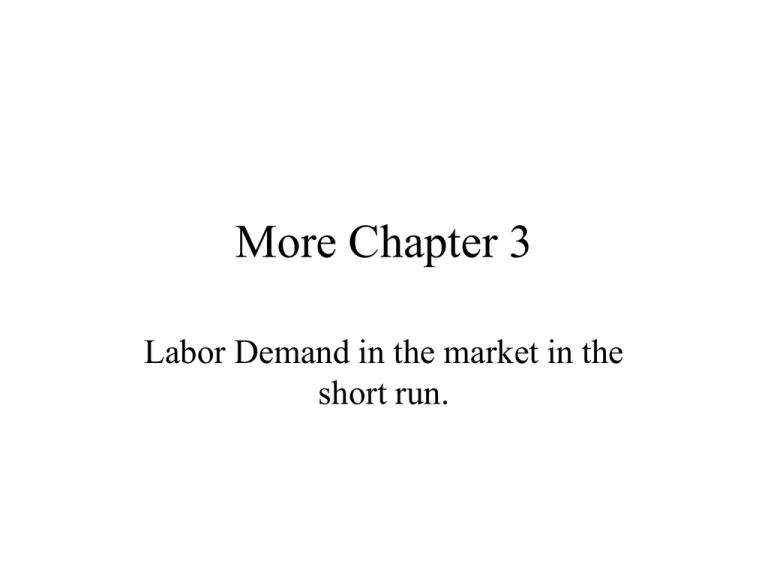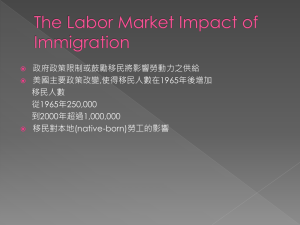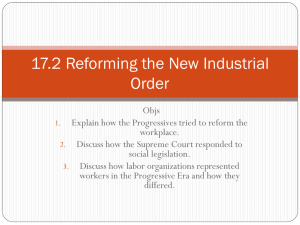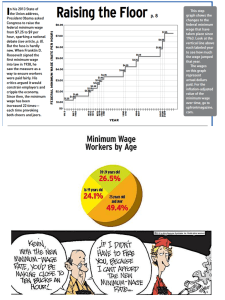SR Demand
advertisement

More Chapter 3 Labor Demand in the market in the short run. The firm’s short run labor demand curve A demand curve is designed to show how the quantity demanded changes or responds when there is a change in the price of the item – here the price is called the wage. The firm is a wage taker here, taken as the market value. The downward sloping portion of the VMP curve below the value of the average product curve is the demand for labor curve because it shows what demand curves are designed to show. Change in labor demand due to output price change Look back at table 3-1 page 90. In the table the VMP was determined with the understanding that the price of output was $2 per unit. Say the output prices rises to $4 per unit. How does the VMP change? The VMP increases at all levels of labor used and thus at a given wage more units of labor will have a VMP greater than the wage and thus the firm would experience an increase in the demand for labor. In this case the demand for labor would shift to the right. How would the curve shift if the output price fell? Short run industry demand curve An industry is a group of firms that make the same type of output. We have assumed the industry is perfectly competitive in that there are so many firms that any one firm has to accept the market price of output. But in a perfectly competitive market if all firms try to increase their supply of output the market price will fall. As a group all firms can influence the market price. This idea has an impact on the short run demand curve for labor in an industry. Short run industry labor demand Wage Wage Curve T is the industry labor demand curve. W1 W2 D2 E1 E2’ Employment Firm D1 E2 T E1 E2’ D E2 Employment Industry Short run industry labor demand On the previous screen say the existing wage is W1. Then the quantity demanded by the firm is E1 and when we add the demand by other firms at this wage we get the total market demand for labor as E1 in that graph. Now say the wage is W2. The firm would initially increase the quantity demanded to E2 and other firms would as well and the market quantity demanded would be E2. BUT, if all firms hire more labor they will expand out and the market price will FALL. This shifts in the firm’s labor demand and thus at W2 the firm only wants E2’. This is true for other firms and so the real increase in the quantity of labor demanded is less than what we might think initially. In other words the industry labor demand in the short run is NOT the horizontal sum of the demand by each firm. Labor Demand and Elasticities 7 In general, the idea of an elasticity is about how much does one variable change, in percentage terms, when another variable changes, and is measured in percentage terms. Why should we care about elasticities? Well, we have theory about how variables are related. Often with a theory we will say if this changes, then that changes. As an example, we say if the wage changes the quantity of labor demanded will change. The concept of elasticity is adding to this idea because we get an amount of the change. Formula In general, an elasticity is a ratio of percentage changes. If A changing causes B to change the elasticity is percentage change in B divided by the percentage change in A. 8 Elasticity of Labor Demand in short run The elasticity of labor demand is The percentage change in the quantity of labor demanded divided by the percentage change in the wage. How do you calculate a percentage change? Normally you take the later value minus the earlier value and divide the result by the earlier value. Let’s do an example on the following screen where we are looking at wage declines. 9 W E % change in E % change in W elasticity 11 0 no change yet no change yet can’t do yet 10 1 (1-0)/0 =undefined (10-11)//11 =-1/11 undefined 9 2 (2-1)/1=1/1 (9-10)/10=-1/10 (1/1)/(-1/10)=-10 8 3 (3-2)/2=1/2 (8-9)/9=-1/9 (1/2)/(-1/9)=-9/2 7 4 1/3 -1/8 -8/3 6 5 1/4 -1/7 -7/4 5 6 1/5 -1/6 -6/5 4 7 1/6 -1/5 -5/6 3 8 1/7 -1/4 -4/7 2 9 1/8 -1/3 -3/8 10 1 10 1/9 -1/2 -2/9 So, on the previous slide you note 1) Since we are looking at wage declines the % change in the wage is negative and the % change in the quantity of labor demanded is positive. 2) The elasticity value is negative. 3) I just wrote the answers in fractional form. So the elasticity of demand is a negative number. Typically we say if the elasticity is: From 0 to, but not including, -1 demand is inelastic; -1 demand is unit elastic; and Less than -1 demand is elastic. 11 Note in our example demand was elastic down to a price of 5 and was inelastic from there on down. The total expenditure on labor equals the wage times the amount of labor demanded. Go back to slide 10 and add the total expenditure on labor for each wage. You will have the values 0, 10, 18, 24, 28, 30, 30, 28, 24, 18, and 10. Note that when the wage falls and demand is elastic the total expenditure rises, or at least never falls, while if the demand is inelastic when the wage falls the total expenditure falls. So, does the total expenditure on labor always fall when the wage falls? No. 12 One more idea In our short run story of marginal productivity theory we said the competitive firm will hire workers up to the point where the VMP = w. This is a statement about taking workers. We could make a statement about taking units of output. Then we would be in the same neighborhood of ideas from a different point of view. It would be kind of like looking at the opposite side of the same coin. Note VMP = price output time p times marginal product MP. So VMP = w means p times MP = w or p = w/MP. One more idea If a unit of labor is added to the firm, additional output results. The labor cost of the worker is the wage and the additional output is the MP. If the marginal cost of an additional unit of output is the change in cost over the change in output, then the wage divided by the MP is the MC. Thus another rule is the competitive firm should add units of output until the MC is equal to the price of output. VMP = w is the same idea p = w/MP = MC.









